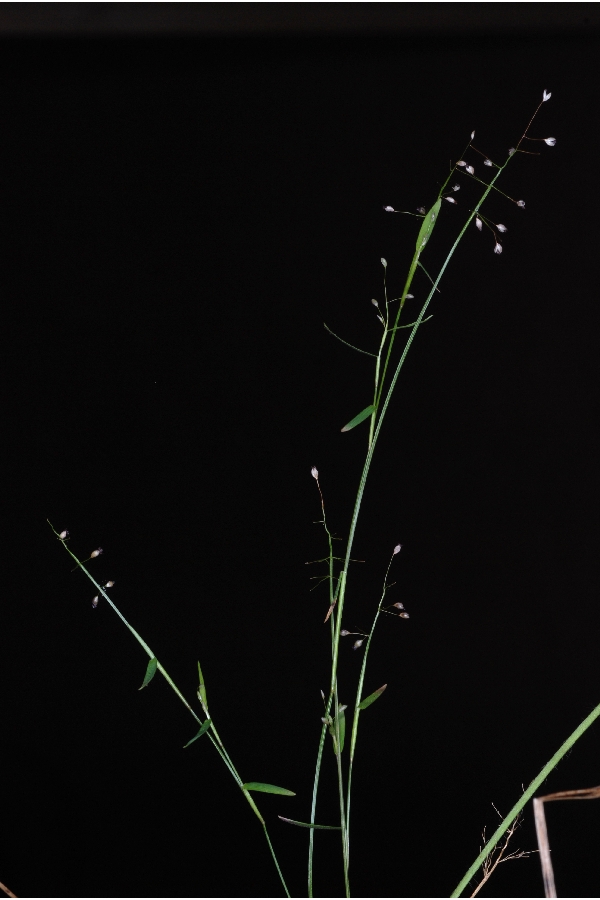Dichanthelium ensifolium
| Dichanthelium ensifolium | |
|---|---|

| |
| Photo by Doug Goldman, hosted by the USDA-NRCS PLANTS Database | |
| Scientific classification | |
| Kingdom: | Plantae |
| Division: | Magnoliophyta - Flowering plants |
| Class: | Liliopsida – Monocotyledons |
| Order: | Poales |
| Family: | Poaceae ⁄ Gramineae |
| Genus: | Dichanthelium |
| Species: | D. ensifolium |
| Binomial name | |
| Dichanthelium ensifolium (Baldw. ex Elliott) Gould & C.A. Clark | |

| |
| Natural range of Dichanthelium ensifolium from USDA NRCS Plants Database. | |
Common names: cypress panicgrass, cypress witchgrass, small-leaved witchgrass
Contents
Taxonomic notes
Synonyms: Panicum ensifolium[1]
Varieties: Dichanthelium flavovirens (Nash) Wipff; D. vernale (A.S. Hitchcock & Chase) Wipff; Panicum ensifolium; P. flavovirens Nash; P. vernale A.S. Hitchcock & Chase[1]
Description
Dichanthelium ensifolium is a perennial graminoid.
Generally, for the Dichanthelium genus, they have "spikelets usually in panicles, round or nearly so in cross section, 2-flowered, terminal fertile, basal sterile, neutral or staminate. First glume usually present, 2nd glume and sterile lemma similar; fertile lemma and palea indurate without hyaline margins. Taxonomically our most difficult and least understood genus of grasses, more than 100 species an varieties are ascribed to the Carolinas by some authors. Note general descriptions for species groups (e.g., 1-4, 5-8, 9-13, and 26-62)."[2]
Specifically, for the D. ensifolium species, they are "very similar to D. tenue." They are a "perennial with distinct basal rosettes; branching, when present, from nodes above basal rosette. Leaves basal and cauline, vernal and autumnal. Very similar to D. tenue. Blade margins not strongly cartilaginous, bases frequently ciliate. Spikelets glabrous or puberulent, 1.3-1.6 mm long."[2]
Distribution
Dichanthelium ensifolium var. breve is endemic to central peninsular Florida to the Lake Wales Ridge area.[3]
Ecology
Habitat
D. ensifolium is found in moist to wet areas, in a variety of soils including peat, sand and silt over clay, loam, and loamy sand.[4] It is found in wet pine savannas,[5] marshes, pine flatwoods, peat-sedge bogs, white cedar swamps, near streams, hillside seepage bogs, riparian mixed hardwood communities, mixed hardwood-bald cypress swamps, and sandhill scrub communities. It also occurs in disturbed habitats including power line corridors, old fields, clear-cut and site prepared pine plantations, roadsides and near trails.[4] however, D. ensifolium was found to be a deacreaser in its long-term response following cessation of repeated soil disturbance.[6]
Associated species include Sphagnum, D. nudicaule, Drosera, Rhynchospora.[4]
Phenology
Species has been observed flowering and fruiting in August, September, November, and December.[4]
Fire ecology
D. ensifolium has been found in burned flatwoods and marshes,[4] with populations known to persist through repeated annual burns.[7]
Average flowering stalk density increased significantly at sites in the first flowering season following fire.[5]
Conservation, cultivation, and restoration
Cultural use
Photo Gallery
References and notes
- ↑ 1.0 1.1 Weakley, A.S. 2020. Flora of the Southeastern United States. Edition of 20 October 2020. University of North Carolina at Chapel Hill, Chapel Hill, North Carolina.
- ↑ 2.0 2.1 Radford, Albert E., Harry E. Ahles, and C. Ritchie Bell. Manual of the Vascular Flora of the Carolinas. 1964, 1968. The University of North Carolina Press. 142-157. Print.
- ↑ Sorrie, B. A. and A. S. Weakley 2001. Coastal Plain valcular plant endemics: Phytogeographic patterns. Castanea 66: 50-82.
- ↑ 4.0 4.1 4.2 4.3 4.4 Florida State University Robert K. Godfrey Herbarium database. URL: http://herbarium.bio.fsu.edu. Last accessed: June 2014. Collectors: Loran C. Anderson, A.E. Radford, R. Kral, H. Kurz, Robert K. Godfrey, Angus Gholson, D. B. Ward, Grady W. Reinert, R. A. Norris, R. Komarek, Cecil R Slaughter, Marc Minno, Bob Fewster Ed Keppner, and Lisa Keppner. States and Counties: Alabama: Houston. Florida: Bay, Brevard, Flagler, Franklin, Gadsden, Hamilton, Holmes, Leon, Nassau, Orange, Osceola, Polk, Putnam, St. Johns, Suwannee, and Wakulla. Georgia: Echols, Grady, and Thomas. North Carolina: Lenoir, Pender, and Pitt.
- ↑ 5.0 5.1 Hinman, S. E. and J. S. Brewer (2007). "Responses of two frequently-burned wet pine savannas to an extended period without fire." Journal of the Torrey Botanical Society 134: 512-526.
- ↑ Dixon, C. M., K. M. Robertson, A. M. Reid and M. T. Rother. 2024. Mechanical soil disturbance in a pine savanna has multiyear effects on plant species composition. Ecosphere 15(2):e4759.
- ↑ Robertson, K.M. Unpublished data collected from Pebble Hill Fire Plots, Pebble Hill Plantation, Thomasville, Georgia.